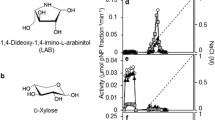Abstract
Mature seeds of Tropaeolum majus L. contain the cell wall polysaccharide xyloglucan (amyloid), protein and lipid as storage substances. The transitory occurrence of starch during the process of seed development could be substantiated.
[U-14C]-labelled xylose, glucose and glucuronic acid were fed to ripening seeds and the incorporation of radioactivity into xyloglucan, starch and the sugar nucleotide fraction of the cotyledons was determined. The results indicate that exogenous supplied xylose is not incorporated directly into xyloglucan, but is transformed to glucose before incorporation into xyloglucan and starch. Radioactivity from glucuronic acid was predominantly found in the xylose moiety of xyloglucan. Incubation of seeds with [6-14C]-labelled glucose resulted in an incorporation of labelled hexoses into amyloid and starch, whereas xylose residues of amyloid remained unlabelled.
Similar content being viewed by others
Abbreviations
- p.a.:
-
post anthesis
- UDP:
-
uridine 5′-diphosphate
- GDP:
-
guanosine 5′-diphosphate
- TLC:
-
thin layer chromatography
- HPLC:
-
high pressure liquid chromatography
References
Asamizu T, Nishi A (1979) Planta 146:49–54
Bauer P, Kopp B, Franz G (1984) Planta med. 1:12–14
Bergmeyer HU (1974) Methoden der enzymatischen Analyse Verlag Chemie, Weinheim
Carpita NC, Delmer DP (1981) J. Biol. Chem. 256:308–315
Courtois JE, Le Dizet P (1974) C. R. Acad. Sci. Ser. C 278:81–83
Edwards M, Dea ICM, Bulpin PV, Reid JSG (1985) Planta 163:133–140
Feingold DS, Neufeld EF, Hassid WZ (1960) J. Biol. Chem. 235:910–913
Gander JE (1976) in: Bonner J, Varner JE Plant Biochem., Academic Press, New York — San Francisco — London, pp 337–380
Gould SEB, Rees DA, Wight NJ (1971) Biochem. J. 124:47–53
Hegnauer R (1973) Chemotaxonomie der Pflanzen, Band 6 Birkhäuser-Verlag, Basel — Stuttgart
Hsu DS, Reeves RE (1967) Carbohydr. Res. 5:202–209
Kooiman P (1960) Rec. Trav. Chim. 79:675–678
Kooiman P (1961) Rec. Trav. Chim. 80:849–865
Kooiman P (1967) Phytochem. 6:1665–1673
Le Dizet P (1972) Carbohydr. Res. 24:505–509
Pubols MH, Zahnley JC, Axelrod B (1963) Plant Physiol. 38:457–461
Siegenthaler U, Ritter W (1977) Mitt. Lebensmitt. Unters. 68:448–450
Spurr A (1969) J. Ultrastruct. Res. 26:31–43
Vogel T, Schleiden MJ (1839) Pogg. Ann. Phys. Chem. 46:327–329
Zahnley JC, Axelrod B (1965) Plant Physiol. 40:372–378.
Author information
Authors and Affiliations
Additional information
Communicated by M. H. Zenk
Rights and permissions
About this article
Cite this article
Hoth, A., Blaschek, W. & Franz, G. Xyloglucan (amyloid) formation in the cotyledons of Tropaeolum majus L. seeds. Plant Cell Reports 5, 9–12 (1986). https://doi.org/10.1007/BF00269706
Received:
Issue Date:
DOI: https://doi.org/10.1007/BF00269706




